Territorial evolution of Canada
| This article is part of a series on |
| Canadian Confederation |
|---|
 |
| Conferences |
| People |
| Related |
|
|
The history of post-confederation Canada began on July 1, 1867, when the
United Province of Canada was immediately split into the provinces of Ontario and Quebec.[2] The colonies of Prince Edward Island and British Columbia joined shortly after, and Canada acquired the vast expanse of the continent controlled by the Hudson's Bay Company, which was eventually divided into new territories and provinces.[3] Canada evolved into a fully sovereign state by 1982.[4]
Before being part of British North America, the constituents of Canada consisted of the
French Canadian nationality was maintained as one of the "two founding nations" and legally through the Quebec Act which ensured the maintenance of the Canadian French language, Catholic religion, and French civil law within Canada, a fact which remains true today.[6]
Canada today has ten provinces and three territories; it only lost significant territory in the border dispute over Labrador with the Dominion of Newfoundland, which later joined Canada as the 10th province.[7]
Timeline
| Date | Event | Change |
|---|---|---|
| July 1, 1867 | The Dominion of Canada was formed by the United Kingdom from three provinces of British North America:[8][a]
The capital was established at Ottawa. Canada inherited territorial disputes with the United States over Machias Seal Island and North Rock, which remain disputed up to the present.[14] |
 Disputes: 
|
| July 15, 1870 | The United Kingdom North-West Territories.[e] Rupert's Land was transferred to Canada in 1869,[18] but the transfer was only consummated in 1870 when £300,000 was paid to the Hudson's Bay Company.[19]
Due to a vague description and lack of quality surveying, part of the western border with the United States was unclear and disputed.[16] Canada disagreed with the United Kingdom over the extent of Labrador that remained with Newfoundland Colony, citing the historical use of the term "Coasts of Labrador ."
A rectangular area of the newly acquired region around the city of |
 Disputes: 
|
| July 20, 1871 | The British colony of British Columbia joined Canada as the sixth province.[21][g] The province brought along its dispute with the United States over the San Juan Islands,[23] as well as its portion of the Alaska boundary dispute.[16]
|
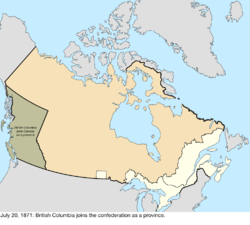 Disputes: 
|
| October 21, 1872 | The dispute with the United States over the San Juan Islands was resolved in favour of the United States claim.[23] |  Disputes: 
|
| July 1, 1873 | The British colony of Prince Edward Island joined Canada as the seventh province.[24] | 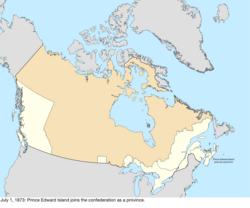
|
| June 26, 1874 | The borders of Ontario were provisionally expanded north and west. When the Province of Canada was formed, its borders were not entirely clear, and Ontario claimed to eventually reach all the way to the Rocky Mountains and Arctic Ocean. With Canada's acquisition of Rupert's Land, Ontario was interested in clearly defining its borders, especially since some of the new areas it was interested in were rapidly growing. After the federal government asked Ontario to pay for construction in the new disputed area, the province asked for an elaboration on its limits, and its boundary was moved north to 51° north, and west to a line running north from Hunter's Island.[25] | 
|
| October 7, 1876 | The District of Keewatin was created from a central strip of the North-West Territories to provide government for the growing area north of Manitoba and west of Ontario; while the North-West Territories consisted of several districts, Keewatin had an elevated status and many sources note it distinct from the rest of the North-West Territories.[h][26] | 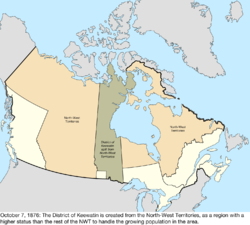
|
| September 1, 1880 | The United Kingdom transferred its archipelago was still being explored and new islands discovered, but the United Kingdom and Canada had claimed the whole archipelago, so new discoveries are not noted unless disputed.
|

|
| December 23, 1881 | Manitoba was expanded, gaining land from the District of Keewatin and North-West Territories to the west, north, and east.[i] Since the province's new eastern border was defined as the "western boundary of Ontario", the exact definition of which was still unclear, Ontario disputed a portion of the new region.[29][28] | 
|
| May 7, 1886 | The southwestern border of the District of Keewatin was adjusted to conform to the boundaries of the provisional districts of the North-West Territories.[j][30] | 
|
| August 12, 1889 | The dispute between Manitoba and Ontario ended as Ontario's borders were finalized, extending the province west to the Lake of the Woods and north to the Albany River.[31] | 
|
| October 2, 1895 | The District of Keewatin was expanded to the portion of the North-West Territories north of Ontario.[32] | 
|
| December 18, 1897 | Southampton Island, Coats Island, Akimiski Island, and other islands were transferred from the North-West Territories to the District of Keewatin, and Boothia Peninsula and Melville Peninsula were transferred from the District of Keewatin to the North-West Territories.[33] | 
|
| June 13, 1898 | Yukon Territory was created from the District of Yukon in the northwestern part of the North-West Territories to supply a more local government to the explosive growth in population due to the Klondike Gold Rush.[k][34][35] Quebec was enlarged north.[36][l]
|

|
| May 23, 1901 | The eastern border of Yukon Territory was adjusted to the Peel River, so that the borders would not cross a watershed, and also to include some more islands, thus exchanging some area with the North-West Territories.[37]
|

|
| October 20, 1903 | The Alaska boundary dispute was resolved, generally in favour of the United States claim.[16] | 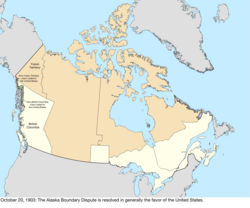 Disputes: 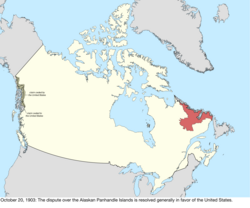
|
| September 1, 1905 | The provinces of Alberta (act) and Saskatchewan (act) were created from the North-West Territories. The provinces consisted of the area between British Columbia, Manitoba, the 60th parallel north, and the United States, with Alberta west of the 4th meridian of the Dominion Land Survey and Saskatchewan east of it. The status of the District of Keewatin was lowered back to the other districts of the North-West Territories.[38][39][40][41][42] | 
|
| 1906 | The North-West Territories were renamed the Northwest Territories.[43][44] | 
|
| September 26, 1907 | The Newfoundland Colony became a dominion of the United Kingdom, inheriting the Labrador boundary dispute. | Disputes: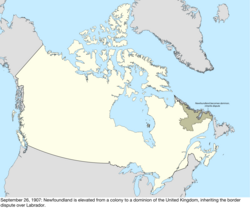
|
| April 11, 1908 | A boundary treaty redefined the maritime border with the United States.[45] Among other changes, this "de-enclaved" Horseshoe Reef in Lake Erie by making the water around it contiguous with the water on the American side of the border.[46][47] | no change to map |
| August 20, 1910 | A boundary treaty with the United States addressed a slight uncertainty in the maritime border in Passamaquoddy Bay between New Brunswick and the United States.[48][49] The border was adjusted to run east of Pope's Folly Island, which previously lay on the border line, and had been the subject of some debate for many years.[50][51] | 
|
| May 15, 1912 | Manitoba, Ontario, and Quebec (act) were all expanded northward into land from the Northwest Territories.[43] Quebec was expanded north to fill the mainland, Manitoba extended north to the 60th parallel north, and the new border between Manitoba and Ontario ran northeast from the previous northeastern corner of Manitoba.[52][53] | 
|
| June 1, 1925 | The maritime boundaries of the Northwest Territories were extended to the North Pole.[43] | no change to map |
| July 17, 1925 | The border with the United States was adjusted in several places. northwestern point of the Lake of the Woods. Finally, the maritime border in the Bay of Fundy was adjusted, netting Canada roughly 9 acres of water.
|
too small to map |
| March 11, 1927 | The Judicial Committee of the British Privy Council decided the Labrador boundary dispute with the Dominion of Newfoundland in favour of Newfoundland.[56][m] Quebec has occasionally indicated it does not recognize this border, but has not actively disputed the matter.[56] |  Disputes: 
|
| November 11, 1930 | Norway ceded its long-dormant claim to the Sverdrup Islands to Canada, in exchange for British recognition of Norway's sovereignty over Jan Mayen. | Disputes:
|
| December 11, 1931 | The Statute of Westminster 1931 confirmed Canada's sovereignty from the United Kingdom on legislative and foreign issues. | no change to map |
| March 31, 1949 | The Dominion of Newfoundland joined as the tenth province, Newfoundland.[57][58] | 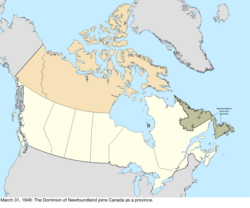
|
| March 13, 1974 | The maritime border with Denmark was defined, notably "skipping" Hans Island which lies directly between Ellesmere Island and Greenland, and which was technically on neither side of the border.[59] | no change to map |
| March 1, 1977 | The United States claimed maritime borders west of the Strait of Juan de Fuca, within the Dixon Entrance, and in the Beaufort Sea that conflicted with claims of Canada.[60] | no change to map |
| April 17, 1982 | The Constitution Act, 1982, via the Canada Act 1982, made Canada completely independent of the United Kingdom, removing the requirement to involve the British parliament in amending the Canadian constitution. | no change to map |
| October 12, 1984 | The International Court of Justice decided the maritime border with the United States in the Gulf of Maine.[61] No land changed hands, and the scope of the case did not include the sovereignty of Machias Seal Island.[60] | no change to map |
| April 1, 1999 | The territory of Nunavut was created from roughly the eastern half of the Northwest Territories.[n][62] | 
|
| December 6, 2001 | The province of Newfoundland was renamed Newfoundland and Labrador.[63] | 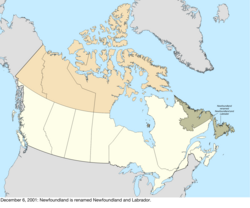
|
| April 1, 2003 | Yukon Territory was renamed Yukon, though it remained a territory.[64] | 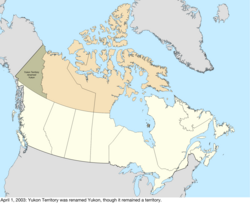
|
| June 14, 2022 | An agreement to redefine the maritime border with Denmark was announced, so that it passes through Hans Island rather than skipping over it.[65] | no change to map |
See also
- Former colonies and territories in Canada
- List of areas disputed by Canada and the United States
- List of Hudson's Bay Company trading posts
- List of French forts in North America
- List of proposed provinces and territories of Canada
- Territorial claims in the Arctic
- Territorial evolution of North America since 1763
Notes
- Newfoundland and Prince Edward Island.[9]
- South Glengarry) and the seigneurie of New Longueuil; north 34° west along the boundary to the western angle of New Longueuil; north 25° east along the boundary to the Ottawa River; up that to the height of the land.[10]
- Missiguash River to a post near Black Island; then a complex of lines through and past Black Island, eventually reaching Tidnish Bridge; then down the Tidnish River to Baie Verte.[13]
- ^ Manitoba was bounded by 96° west, 99° west, 50°30′ north, and 49° north.[20]
- ^ The new borders of Canada were, from the existing Canada-United States border where the ridge of the Rocky Mountains crosses 49° north: west to the Pacific Ocean, through the Strait of Juan de Fuca, around Vancouver Island and Haida Gwaii to the Dixon Entrance; back on land where it ran north along the disputed border with the United States; then up that to where it met the existing border.[22]
- ^ The District of Keewatin was defined as the mainland area west of Ontario and Hudson Bay; east of Lake Manitoba, Lake Winnipegosis, and Cedar Lake, and a line north from Cedar Lake; and north of the United States.
- ^ Manitoba's new western and northern borders were defined only by township ranges and survey borders, with the southern border being the United States and the eastern border being Ontario.[28]
- ^ The new border transferred land from the District of Keewatin west of the Nelson River and Lake Winnipeg, south of a line extending east from the northern border of the District of Saskatchewan, and north of Manitoba, to the North-West Territories.[30]
- ^ The borders of Yukon Territory were, from the Arctic Ocean: south along the international boundary to 60° north; east to the Liard River; north along the river to the height of the land; along that, approximately parallel to the Peel River, to 136° west; then north.[34]
- ^ The new northern border of Quebec was, starting from James Bay: up the Eastmain River to its source; east to the Hamilton River; then down that to the border with Newfoundland, which was still heavily disputed.[35]
- Blanc-Sablon on the Gulf of St. Lawrence: north to 52° north; west to the height of the land; then following that around to include the watershed of the eastern coast of the Labrador Peninsula.[56]
- ^ The Northwest Territories-Nunavut border was complex and described in Schedule I of the Nunavut Act.[62]
References
- ISBN 978-0-8020-9468-1.
- ISBN 978-0-19-994882-6.
- ISBN 978-0-19-927164-1.
- ISBN 978-1-55238-046-8.
- ISBN 978-0-7710-0338-7.
- ISBN 978-0-7735-3890-0.
- ISBN 978-1-61069-106-2.
- ^ . March 29, 1867 – via Wikisource.
- ^ "Text of "The Webster–Ashburton Treaty"". The Avalon Project at Yale Law School. Retrieved 2023-11-29.
- ^ Scadding, Henry (1876). First Gazetteer of Upper Canada. Copp, Clark & Company. p. 58. Retrieved April 1, 2019.
- ^ Boundary Line Between Canada & New Brunswick. 1856.
- ^ Ganong, William Francis (1901). A monograph of the evolution of the boundaries of the Province of New Brunswick. p. 402.
- ^ Ganong, William Francis (1901). A monograph of the evolution of the boundaries of the Province of New Brunswick. p. 369.
- ^ O'Connor, Joe (November 27, 2012). "Puffin Wars: The island paradise at centre of last Canada-U.S. land dispute". National Post. Retrieved April 1, 2019.
- OCLC 69426475.
- ^ OCLC 69426475.
- ^ "History of Canada". Government of Canada. Retrieved April 1, 2019.
- ^ . July 31, 1868 – via Wikisource.
- ^ . June 23, 1870 – via Wikisource.
- ^ a b . May 12, 1870 – via Wikisource.
- ^ . May 16, 1871 – via Wikisource.
- ^ Rickards, Sir George Kettilby (1866). "The British Columbia Act, 1866". Retrieved April 1, 2019.
- ^ OCLC 69426475.
- ^ . June 26, 1873 – via Wikisource.
- ^ Mills, David (1877). Report on the Boundaries of the Province of Ontario. Toronto: Hunter, Rose & Co. p. 347.
- ^ Nicholson, Norman L. (1979). The Boundaries of the Canadian Confederation. Toronto: Macmillan Company of Canada Ltd. p. 113.
- ^ . July 31, 1880 – via Wikisource.
- ^ a b Canada (3 August 1881). "Acts of the Parliament of the Dominion of Canada". Brown Chamberlin, Law Printer to the Queen's Most Excellent Majesty – via Google Books.
- ^ "Land Surveying in Manitoba". Association of Manitoba Land Surveyors. Retrieved November 29, 2023.
- ^ a b Canada; Bligh, Harris Harding (3 August 1889). "The Consolidated Orders in Council of Canada: Under the Authority and Direction of His Excellency the Governor-general in Council". B. Chamberlain – via Google Books.
- ^ . August 12, 1889 – via Wikisource.
- ^ Keltie, J. Scott, ed. (1899). The Statesman's Year-Book. London: MacMillan & Co. p. 223.
- ^
Extract from Order in Council (Dominion) of the 18th December, 1897, Establishing Provisional Districts in the Unorganized Portions of Canada (PDF). The Labrador Boundary Dispute Documents (Report). Vol. VIII. pp. 4012–4013. Retrieved May 9, 2014.
The District of Franklin (situated inside of the grey border on the map herewith) comprising Melville and Boothia Peninsulas, ...
- ^ a b Canada (1896). Acts of the Parliament of the Dominion of Canada. p. xlviii. Retrieved March 29, 2019.
- ^ a b . June 13, 1898 – via Wikisource.
- ^ . June 13, 1898 – via Wikisource.
- ^ Yukon Territory Act, S.C. 1901, c. 41, s. 14
- ^ . July 20, 1905 – via Wikisource.
- ^ . July 20, 1905 – via Wikisource.
- ^
Thomson, Malcolm M.; Tanner, Richard W. (April 1977). "Canada's Prime Meridian". Bibcode:1977JRASC..71..204T.
- ^ Widdis, Randy (2006). "49th Parallel". The Encyclopedia of Saskatchewan. Canadian Plains Research Center, University of Regina. Retrieved January 6, 2009.
- ^ Lewry, Marilyn (2006). "Boundary surveys". The Encyclopedia of Saskatchewan. Canadian Plains Research Center, University of Regina. Retrieved January 6, 2009.
- ^ a b c "History of the Name of the Northwest Territories". Prince of Wales Northern Heritage Centre. Retrieved October 17, 2015.
- ^ c.62, RSC 1906
- OCLC 69426475.
- ^ Treaty between the United States of America and the United Kingdom Concerning the Boundary between the United States and the Dominion of Canada from the Atlantic Ocean to the Pacific Ocean, signed April 11, 1908; accessed June 30, 2015
- ^ International Boundary between the United States and the Dominion of Canada through the St. Lawrence River and Great Lakes, Sheet No. 12 – Niagara River (Map). Buffalo, New York: International Waterways Commission. August 15, 1913. Retrieved 2016-08-08.
- ^ 36 Stat. 2477
- ^ Van Zandt, p. 20
- ^ "Who Owns Pope's Folly Island?". The New York Times. June 20, 1893. Retrieved May 11, 2015.
- ^ Link to a download for the United States Geological Survey map of the Eastport Quadrangle from 1907: [1]
- ^ "Manitoba Boundaries Extension Act, 1912". solon.org. Archived from the original on November 11, 2020. Retrieved October 3, 2023.
- ^ "Ontario Boundaries Extension Act".
- ^ "Treaty Between Canada and the United States of America to define more accurately and to complete the International Boundary between the two Countries" (PDF). February 24, 1925. Archived from the original (PDF) on 2016-08-16. Retrieved May 8, 2015.
- ^ Van Zandt, pp. 21–22
- ^ a b c "Henri Dorion debunks the Ten Great Myths about the Labrador boundary". Quebec – National Assembly – First Session, 34th Legislature. October 17, 1991. Archived from the original on October 26, 2009. Retrieved October 17, 2015.
- ^ . March 23, 1949 – via Wikisource.
- ^ Webb, Jeff A. (March 2008). "The Commission of Government, 1934-1949". Heritage: Newfoundland & Labrador. Memorial University of Newfoundland and the C.R.B. Foundation. Retrieved October 17, 2015.
- ^ "Agreement relating to the delimitation of the continental shelf between Greenland and Canada (with annexes); signed December 17, 1973; United Nations Treaty Series 13550" (PDF). Retrieved May 12, 2017.
- ^ a b Gray, David H. (Autumn 1997). "Canada's Unresolved Maritime Boundaries" (PDF). IBRU Boundary and Security Bulletin. pp. 61–67. Retrieved 2015-03-21.
- ^ Case Concerning Delimitation of the Maritime Boundary in the Gulf of Maine Area (Canada v. United States) Archived 2016-08-17 at the Wayback Machine, accessed June 30, 2015
- ^ a b "Nunavut Act". Government of Canada. Retrieved May 12, 2017.
- ^ "Constitution Amendment, 2001 (Newfoundland and Labrador)". Government of Canada. December 6, 2001. Archived from the original on August 31, 2014. Retrieved October 17, 2015.
- ^ "Yukon Territory name change to Yukon" (PDF). Library and Archives Canada. April 1, 2003. Retrieved July 14, 2009.
- ^ Austen, Ian (June 14, 2022). "After 49 years, Canada and Denmark Settle the Ownership of an Arctic Island". The New York Times. Retrieved June 14, 2022.
Further reading
- "Territorial Evolution". The Atlas of Canada. Natural Resources Canada. June 3, 2015.
- Hayes, Derek (2002). Historical Atlas of Canada. Douglas & McIntyre. ISBN 1-55054-918-9.
- Matthews, Geoffrey J (1987). Historical atlas of Canada, Volume 1. University of Toronto Press. ISBN 0-8020-2495-5.
External links
Wikimedia Commons has media related to Territorial evolution of Canada.
- The Atlas of Canada - Territorial Evolution from 1867 to 2017
- Territorial Evolution, 1670–2001 – Historical Atlas of Canada
